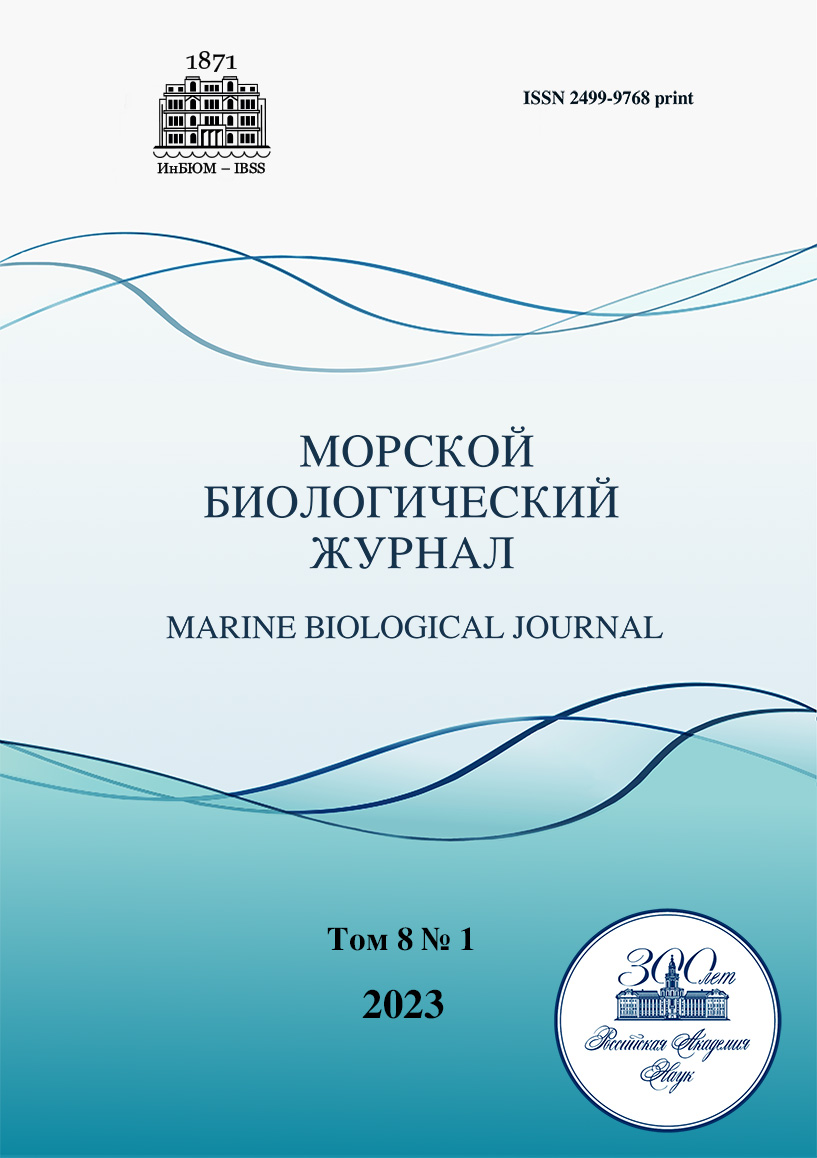Relationship between growth characteristics of microalgae culture and age-specific cell state in ontogenesis (probabilistic model)
##plugins.themes.ibsscustom.article.main##
##plugins.themes.ibsscustom.article.details##
Abstract
The article presents a quantitative model of the dependence of the morphological structure of the continuous microalgae culture on external lighting and species-specific cell parameters. The modeling is based on the concept of two main phases that make up the cell life cycle – interphase and division phase. The interphase is regarded as a light-dependent process during which cell biomass increases. The division phase does not depend on light and occurs when a cell reaches a certain mass equal to (or higher than) the sum of masses of daughter cells. The division stage ends with cytokinesis: a cell splits into daughter cells. The age-specific microalgae cell state is characterized by the value of its biomass, while transitions from one state to another are characterized by the activity (growth and division). The model is represented by a system of differential equations that fully describe the dynamics of ontogenesis. A particular solution of the model for dynamically equilibrium growth of microalgae in the culture at different light intensity is analyzed. As shown, in the continuous microalgae culture under photolithotrophic conditions, the specific growth rate is related to the morphological structure of the cell population by simple directly proportional equations with species-specific coefficients. These coefficients are the maximum growth rate in the interphase (at saturating light intensity) and cell division activity in mitosis.
Authors
References
Карлин С. Детерминированный рост популяции с распределением по возрастам // Карлин С. Основы теории случайных процессов. Москва : Мир, 1968. С. 387–395. [Karlin S. Determinirovannyi rost populyatsii s raspredeleniem po vozrastam. In: Karlin S. Osnovy teorii sluchainykh protsessov. Moscow : Mir, 1968, pp. 387–395. (in Russ.)]
Лелеков А. С., Тренкеншу Р. П. Моделирование световых кривых фотосинтеза линейными сплайнами // Экология гидросферы. 2019. № 2 (4). С. 20–29. [Lelekov A. S., Trenkenshu R. P. Modeling of photosynthesis light curves by linear splines. Ekologiya gidrosfery, 2019, no. 2 (4), pp. 20–29. (in Russ.)]. https://doi.org/10.33624/2587-9367-2019-2(4)-20-29
Ризниченко Г. Ю. Лекции по математическим моделям в биологии. Москва : Изд-во РХД. 2011. 560 с. [Riznichenko G. Yu. Lektsii po matematicheskim modelyam v biologii. Moscow : Izd-vo RKhD, 2011, 560 p. (in Russ.)]
Степанова Н. В. Математические модели непрерывной культуры микроорганизмов, распределённых по возрастам и размерам // Математические модели в экологии. Горький : Изд-во ГГУ. 1980. С. 95–113. [Stepanova N. V. Matematicheskie modeli nepreryvnoi kul’tury mikroorganizmov, raspredelennykh po vozrastam i razmeram. In: Matematicheskie modeli v ekologii. Gorky : Izd-vo GGU, 1980, pp. 95–113. (in Russ.)]
Стуколова И. В., Тренкеншу Р. П. Основные типы питания водорослей (краткий глоссарий) // Вопросы современной альгологии. 2020. № 1 (22). С. 34–38. [Stukolova I. V., Trenkenshu R. P. The main types of algae nutrition (short glossary). Voprosy sovremennoi algologii, 2020, no. 1 (22), pp. 34–38. (in Russ.)]. https://doi.org/10.33624/2311-0147-2020-1(22)-34-38
Тренкеншу Р. П., Лелеков А. С., Новикова Т. М. Линейный рост морских микроводорослей в культуре // Морской биологический журнал. 2018. Т. 3, № 1. С. 53–60. [Trenkenshu R. P., Lelekov A. S., Novikova T. M. Linear growth of marine microalgae culture. Morskoj biologicheskij zhurnal, 2018, vol. 3, no. 1, pp. 53–60. (in Russ.)]. https://doi.org/10.21072/mbj.2018.03.1.06
Цоглин Л. Н. Циклы развития клеток и физиологические свойства популяций микроводорослей : автореф. дис. … д-ра биол. наук : 03.00.12. Москва, 1996. 77 с. [Tsoglin L. N. Tsikly razvitiya kletok i fiziologicheskie svoistva populyatsii mikrovodoroslei : avtoref. dis. … d-ra biol. nauk : 03.00.12. Moscow, 1996, 77 p. (in Russ.)]
Цоглин Л. Н., Клячко-Гурвич Г. Л. Изменение функциональной активности хлоропласта в клеточном цикле хлореллы // Физиология растений. 1980. Т. 27, № 6. С. 1172–1179. [Tsoglin L. N., Klyachko-Gurvich G. L. Changes in functional activity of the chloroplast in the chlorella cell cycle. Fiziologiya rastenii, 1980, vol. 27, no. 6, pp. 1172–1179. (in Russ.)]
Цоглин Л. Н., Пронина Н. А. Биотехнология микроводорослей. Москва : Научный мир, 2012. 184 с. [Tsoglin L. N., Pronina N. A. Biotekhnologiya mikrovodoroslei. Moscow : Nauchnyi mir, 2012, 184 p. (in Russ.)]
Cvrčková F. A brief history of eukaryotic cell cycle research. In: Concepts in Cell Biology – History and Evolution / V. P. Sahi, F. Baluška (Eds). Cham, Switzerland : Springer, 2018, pp. 67–93. (Plant Cell Monographs (CELLMONO ; vol. 23)). https://doi.org/10.1007/978-3-319-69944-8_4
Helmstetter Ch. E. A ten-year search for synchronous cells: Obstacles, solutions, and practical applications. Frontiers in Microbiology, 2015, vol. 6, art. no. 238 (10 p.). https://doi.org/10.3389/fmicb.2015.00238
Novák B., Tóth A., Csikász-Nagy A., Györffy B., Tyson J. J., Nasmyth K. Finishing the cell cycle. Journal of Theoretical Biology, 1999, vol. 99, iss. 2, pp. 223–233. https://doi.org/10.1006/jtbi.1999.0956
Pederson T. Historical review: An energy reservoir for mitosis, and its productive wake. Trends in Biochemical Sciences, 2003, vol. 28, iss. 3, pp. 125–129. https://doi.org/10.1016/s0968-0004(03)00030-6
Sasabe M., Machida Y. Signaling pathway that controls plant cytokinesis. In: Signaling Pathways in Plants / Y. Machida, C. Lin, F. Tamanoi (Eds). London ; San Diego ; Oxford : Academic Press, 2014, chap. 6, pp. 145–165. (The Enzymes ; vol. 35). https://doi.org/10.1016/B978-0-12-801922-1.00006-3
Sible J. C., Tyson J. J. Mathematical modeling as a tool for investigating cell cycle control networks. Methods, 2007, vol. 41, iss. 2, pp. 238–247. https://doi.org/10.1016/j.ymeth.2006.08.003
Tyson J. J., Novák B. Regulation of the eukaryotic cell cycle: Molecular antagonism, hysteresis, and irreversible transitions. Journal of Theoretical Biology, 2001, vol. 210, iss. 2, pp. 249–263. https://doi.org/10.1006/jtbi.2001.2293
Tyson J. J., Novák B. Temporal organization of the cell cycle. Current Biology, 2008, vol. 18, iss. 17, pp. R759–R768. https://doi.org/10.1016/j.cub.2008.07.001
Tyson J. J., Novák B. Models in biology: Lessons from modeling regulation of the eukaryotic cell cycle. BMC Biology, 2015, vol. 13, iss. 1, art. no. 46 (10 p.). https://doi.org/10.1186/s12915-015-0158-9
Wang J. D., Levin P. A. Metabolism, cell growth and the bacterial cell cycle. Nature Reviews Microbiology, 2009, vol. 7, iss. 11, pp. 822–827. https://doi.org/10.1038/nrmicro2202
Wilkins A. S., Holliday R. The evolution of meiosis from mitosis. Genetics, 2009, vol. 181, iss. 1, pp. 3–12. https://doi.org/10.1534/genetics.108.099762
Winter A. W. Ueber die Vermehrung der Pflanzen-Zellen durch Theilung. [dissertation]. Tübingen : L. F. Fues, 1835. 20 S.


 Google Scholar
Google Scholar



